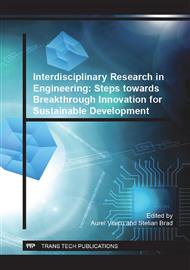[1]
A. Baya, S. Muntean, V.C. Campian, A. Cuzmos, M. Diaconescu, M. Balan, Experimental investigations of the unsteady flow in a Francis turbine draft tube cone, IOP Conf. Ser.: Earth Environ. Sci. 12 (2010) 012007.
DOI: 10.1088/1755-1315/12/1/012007
Google Scholar
[2]
D. Frunzaverde, S. Muntean, G. Marginean, V. Campian, L. Marsavina, R. Terzi, V. Serban, Failure analysis of a Francis turbine runner, IOP Conf. Ser.: Earth Environ. Sci. 12 (2010) 012115.
DOI: 10.1088/1755-1315/12/1/012115
Google Scholar
[3]
D. Chiorean, I. Rogoz, I. Poienariu, Technical problems arising from the operation of hydraulic turbines at SHC, Timisoara Academic Days, XI Edition, Timisoara, (2009) 1-8.
Google Scholar
[4]
N. Pasca, L. Marsavina, S. Muntean, R. Negru: submitted to Engineering Failure Analysis (2013).
Google Scholar
[5]
H. Brekke, Performance and safety of hydraulic turbines, IOP Conf. Ser.: Earth Environ. Sci. 12 (2010) 012061.
DOI: 10.1088/1755-1315/12/1/012061
Google Scholar
[6]
S. Muntean, I. Ninaci, R. Susan-Resiga, A. Baya, I. Anton, Numerical analysis of the flow in the old Francis runner in order to define the refurbishment strategy, UPB Scientific Bulletin Series D: Mechanical Engineering 72 (2010) 117-124.
Google Scholar
[7]
J. Roesler, H. Harders, M. Baeker, Mechanical Behaviour of Engineering Materials, Springer-Verlag, Berlin, (2007).
Google Scholar
[8]
ASM Handbook, vol. 8, Mechanical Testing and Evaluation, ASM International, Materials Park, (2000).
Google Scholar
[9]
N. Natsume, Y. Hayashi, H. Akebono, M. Kato, A. Sugeta, Fatigue properties and crack propagation behavior of stainless cast steel for turbine runner of hydraulic power generation, J. Proc. Eng. 2 (2010) 1273-1281.
DOI: 10.1016/j.proeng.2010.03.138
Google Scholar
[10]
H. Nakazawa, S. Kodama, Statistical fatigue testing method with 14 specimens – JSME standard method for determination of S-N curves, in: T. Tanaka, S. Nishijima, M. Ichikawa (Eds. ), Statistical Research on Fatigue and Fracture (Current Japanese Materials Research, vol. 2), Elsevier Applied Science Publishers Ltd., Essex, England, 1987, pp.59-69.
Google Scholar
[11]
Y.L. Lee, J. Pan, R.B. Hathaway, M.E. Barkey, Fatigue Testing and Analysis (Theory and Practice), Elsevier Butterworth-Heinemann, Burlington, (2005).
Google Scholar
[12]
C.L. Shen, P.H. Wirshing, G.T. Cashman, Design curve to characterize fatigue strength, J. Eng. Mater. -T. ASME 118 (1996) 535-541.
DOI: 10.1016/s0142-1123(97)82623-0
Google Scholar
[13]
C.R. Williams, Y. Lee, J.T. Rilly, A practical method for statistical analysis of strain-life fatigue data, Int. J. Fatigue 25 (2003) 427-436.
DOI: 10.1016/s0142-1123(02)00119-6
Google Scholar
[14]
W.J. Dixon, A.M. Mood, A method for obtaining and analyzing sensitivity data, J. Am. Stat. Assoc. 43 (1948) 109-126.
Google Scholar
[15]
A. De Iorio, M. Grasso, F. Penta, G.P. Pucillo, A three-parameter model fatigue crack growth data analysis, Frattura ed Integrita Strutturale 21 (2012) 21-29.
DOI: 10.3221/igf-esis.21.03
Google Scholar
[16]
P.C. Paris, F. Erdogan, A critical analysis of crack propagation laws, J. Basic Eng. -T. ASME 85 (1963) 528-534.
DOI: 10.1115/1.3656902
Google Scholar
[17]
K. Walker, The effects of stress ratio during crack propagation and fatigue for 2024-T3 and 7075-T6 aluminum, in: Effects of Environment and Complex Load History for Fatigue Life, ASTM STP 462, Philadelphia, 1970, pp.1-14.
DOI: 10.1520/stp32032s
Google Scholar
[18]
O. Wheeler, Spectrum loading and crack growth, J. Eng. Mater. -T. ASME 94 (1972) 181-186.
Google Scholar


